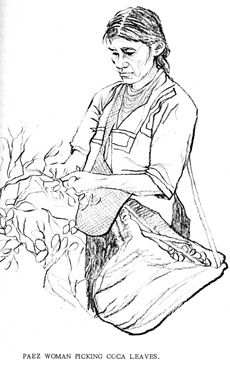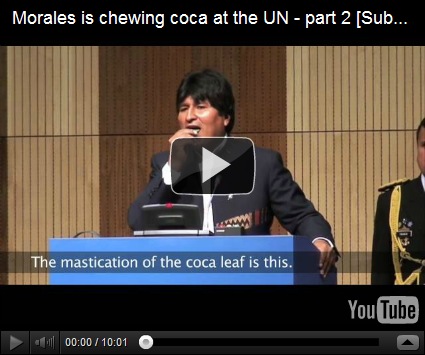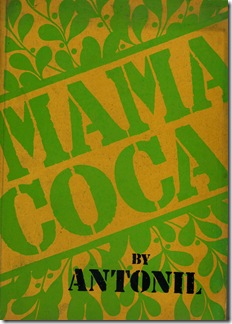http://www.mama-coca.de/viewpage.php?page_id=10
Earlier this month, the Bolivian President Evo Morales once more addressed a UN anti-drugs meeting to try and right a historic wrong.
Under the 1961 UN Single Convention on Narcotic Drugs, the coca leaf was declared an illegal substance and it called for the elimination of coca-chewing within 25 years of the convention coming into effect in 1964. Some chance.
As Morales points out, the coca leaf has been part of Bolivian culture for thousands of years for sacred, cultural and practical reasons – drinking coca tea helps alleviate the effects of high altitude.
Coca tea is just one of numerous products made from second-rate leaves, which include sweets, marmalade and soap. Only the best coca leaves are used for chewing.
Morales was a coca leaf farmer who became leader of the ‘cocalero’ (coca famers) union before being twice voted in as President of Bolivia. It was the first time in the whole history of Latin America that an indigenous candidate became president of a republic.
According to The Guardian Weekend, in February 2012 ‘The UN’s drugs board slammed Morales for defending coca’s non-narcotic use, saying it went against international drug conventions, and for not doing enough to combat its illegal trade. But Morales maintains he cannot defeat traffickers without a reduction in cocaine use in the west.’ The UN claim that 36,000 tonnes of coca leaf a year are produced in Bolivia by the illegal coca trade to produce cocaine.
These two videos (with English subtitles) show Morales’ speech at the 52nd session of the Commission on Narcotic Drugs of the High-level Segment/Vienna/March 11-12 2009, during which he pops a coca leaf in his mouth.
THE GENERALIST first became aware of coca leaf and it culture thanks to this remarkable book by Antonil. which, for the first time in the West, reported on the ‘war on drugs’ – which was already taking place on the continent. This is a rare signed copy of the first edition, No 86 of a limited edition of 350 copies, published by Practical Paradise  Publications. I was given the copy when I went to interview the author in 1981.
Publications. I was given the copy when I went to interview the author in 1981.
The book’s blurb reads: ‘Being conceived in terms of a quest for the mythological spirit which resides within the coca bush, MAMA COCA is both a searing indictment of the monopolization of the cocaine traffic by the reactionary security forces, and a passionate defence of the habit of chewing coca leaves in their natural unrefined state.’
The material in the book was collected in Colombia on a two-month trip in 1971 and ‘a longer permanence’ in the Caucau area throughout 1973 and 1974. Antonil is the pen name of Anthony Henman who is still active on this subject and others. Here is a recent photo and an interesting and powerful 2003 interview with him from stopthedrugwar.org.
Presentación del informe final de la Comisión Latinoamericana Drogas y Democracia:Hacia un Cambio de Paradigma, Centro de convenciones Colegio Médico. 8 febrero 2010. Foto:Luis Gavancho. http://legalizaperu.wordpress.com/galeria/antony-henman/
In 1978, Cambridge-educated anthropologist and author Anthony Henman published "Mama Coca," a groundbreaking work of ethnobotanical anthropology that for the first time showed Westerners not only the indigenous coca culture of the Andes but also the beginnings of the politics of coca and cocaine prohibition and how they impacted traditional cultures. Since then, Henman has continued to work as an anthropologist and expert on psychoactive substances in the Western Hemisphere, and was honoured with a keynote address at the Global Social Thematic Forum in Cartagena, Colombia, this week. DRCNet spoke with Henman in Cartagena on Tuesday evening.
The Week Online: How did you come to write "Mama Coca," and what happened once it was published?
Anthony Henman: I first came to Colombia in the early 1970s. Things were wide open then; there was an open cannabis market in Bogota, and cocaine was just beginning to appear. At that point, I wasn't really interested in cocaine; I was more of a toker at the time. In 1973, I finished my university studies at Cambridge and was offered a job in Popayan, the regional capital of the traditional coca growing area in Colombia. It was very much a part of the gringo trail at the time, with all kinds of travelling hippies coming through town. There was very good weed, the Colombian red bud. And then there was the very traditional country scene as well.
I was amazed at peoples' different reactions to the coca leaf. Having lived through all that, and given my interest in the plant and its traditional use, I couldn't ignore what was beginning to happen at the time. That was the first area that set up cocaine processing kitchens, although they produced pounds, not tons. And the cocaine always came out different, sometimes pink, sometimes off-white, which proved that is was coming from a number of small labs, not the monopoly business we have now. Actually, I doubt that even today it is as much a monopoly as portrayed by the media.
"Mama Coca" was originally conceived as a classic conventional anthropological description of coca use, and cocaine was not originally part of what I had planned. But cocaine was coming on top of the traditional use, and I couldn't ignore it.
While people were interested in the ethno-botanical stuff, what made "Mama Coca" notorious was that it was the first time anyone got into print with criticisms and allegations against the war on drugs and the drug warriors. There was a chapter in the middle of the book that dealt with that.
For my efforts, I got harassed by immigration officials for years to come, and in Britain the book was seized by police and the publisher was prosecuted under the Obscene Publications Act. I guess they read the act broadly, since it is supposed to cover works likely to "corrupt or deprave." We got a lot of notoriety in the press, but it didn't do us much good, since all the copies had been seized and were sitting in a warehouse. The prosecution lost the case in 1984, but it still took us nine more months to get the books back, and by then everyone had lost interest.
It's a good example of how official harassment can be effective even when they don't have a good legal case. It wasn't too good for my career as an author either, because it discouraged British publishers from publishing books about drugs or ever having anything to do with me again.
SOURCE: mamacoca.org
WOL: What have you been doing since then?
Henman: I've done research on lots of other sorts of drugs and drug use. I studied mushrooms in Wales for my doctoral thesis, and I did a lot of work on drug prescribing and needle exchange programs in Liverpool and New York, including a major evaluation of needle exchanges in the late 1990s in New York. It was an annual report for the Department of Health. I've also published a few papers about empowering drug users and their organizations in that context.
WOL: Are you affiliated with the organization Mama Coca?
Henman: No. They asked my permission to use the name, and I said of course. We also correspond all the time, but I am not a member.
WOL: What are you doing these days?
Henman: I'm working on a research project in Peru on mescaline-containing cacti, specifically the San Pedro. There are three different species of San Pedro, with slight differences among the three. I'm trying to collect as many as I can in their native environments. I am not a chemist, so I try to feel what the difference may be by subjective experimentation. I've tried different ways of preparing it, but it still tastes pretty awful. Still, it is very much the basis of traditional medicine in northern Peru and coastal Peru. It is the basis for divination and curing, but I find the doses they use for those purposes disappointingly small. People feel a little strange, but they don't really trip. The curanderos, however, are a different story; they sip it all day long. It is not discussed as a drug problem; in fact, it is even legal in the US, and you will find it in every garden store that carries cacti, because it is very good for root stock. It spread all around the world as root stock, and that was before anyone knew it contained mescaline.
My main interest has always been the coca leaf, but while it has interesting botanical, medicinal and ethnographic aspects, it is a subject that is becoming over-determined by the current politics of the cocaine business -- the violence, the corruption, all that -- so it difficult to talk about coca leaves as a traditional path in Colombia. You can do that in Bolivia or Peru, where it is still legal, but here in Colombia, when the public hears coca, it thinks of Pablo Escobar. I find it tedious and tiresome that one cannot talk about the interesting uses of coca in Colombia. This drug prohibition and drug trafficking nightmare will eventually end, or if not, the whole planet will be destroyed by it. I hope drug law reform will end this nightmare and people can get back to understanding these plants as they really are.
WOL: How do you look at coca?
Henman: Coca is not just an object for our consumption, but a historical subject in itself. First, we have to erase from our minds the image of the damned leaf. Coca doesn't deserve the sobriquet. It's a plant, and like every other species, it wants to reproduce. It is a hermaphrodite, it is very fertile, and it is chock full of alkaloids. It is a dangerous plant, some say, a liar, a traitor. But I say that this slander of the coca plant is hideously repugnant. After 50 years of war against coca, we have not met one goal of the anti-coca policies. The plant continues to reproduce. Even worse, every time there is a change of ministers, they come out with the same banalities about how they will fight the plant endlessly and how they will win. They can't win, but they always say they are on the verge of winning. A war against coca can never bring anything positive to the planet, despite what they say. We have to change our perspective completely and become at peace with coca as it deserves, for it is a plant with many virtues. Perhaps they can't eradicate coca because the objective is mistaken; perhaps it is because the real objectives of the war on drugs have nothing to do with their declared objectives. But I think this will pass; I can imagine a day when it is cultivated on a legal basis wherever it is advisable.
This war on coca is violence and killing without end. They say they are doing this killing and poisoning for the good of all. How absurd! It is absurd because what they accomplish is to make coca part of a malignant trade all over the planet. This has people thinking about the legalization of coca. That would be good. It would eliminate the negative aspects, especially the criminal aspect, which, after all, are not part of the coca plant, but part of drug prohibition.
*
COCA DRINKS
This is a coca-based energy drink, launched in Colombia in 2005.
According to Sibylla Brodzinsky, writing from Bogota for The Guardian [14.12.05]: ‘The drink is the colour of cider, has a tea-like aroma and is described as tasting like a cross between lemonade and ginger ale.’
According to a 2007 post on the blog Rob’s Place:
Colombia’s president Alvaro Uribe.. has now decided to focus on coca products made by the country’s indigenous Indians, the sale of which, outside Indian reservations, will now be banned. The main item affected is , a coca-based energy drink… which has become an alternative to the real thing, aka Coca-Cola among Colombia’s kids. It’s obvious what prompted this new measure: pressure from Coca-Cola. No matter that the US giant itself uses coca in the flavouring for its own fizzy drink (allegedly): the Nasa Indian tribe, who make Coca Sek, are still being told that their brew infringes the 1961 treaty banning the distribution of products with the slightest trace of coca.
Brodzinsky interviewed Kirsten Watt, a Coca-Cola spokeswoman in Atlanta: ‘As for its ingredients, Coca-Cola was tight lipped. “Cocaine has never been an ingredient,” Ms Watt said, though she declines to say whether cocaine-free coca extract is part of the drink’s secret recipe, as has been widely reported.’
THE PERUVIAN EQUIVALENT – COCA MAX www.cocamax.com/
POSTER SHOWING THE MEDICAL BENEFITS OF COCA
BOLIVIA launched their energy drink Coca Brynco in January 2011. According to the Daily Mail:
‘It has been hailed by the Bolivian government as an important step in its efforts to promote coca's health benefits and develop legal uses for its leaves.
‘Two years ago, another group of Bolivian entrepreneurs launched a coca-based energy drink called Coca Colla but it failed to make an impact.
‘But Coca Brynco's production manager, Jhonny Vargas, was optimistic the planned $million (£620,000) investment would pay off.
'Our aim is to cover the whole of Bolivia and start exporting to neighbouring countries,' he said, adding that the plant would initially use 500lbs of coca leaves per month.’
PREVIOUS POSTS:
INSIDE DOPE; DRUG LAWS, DRUG WARS
INSIDE DOPE; DRUG LAWS, DRUG WARS2









1 comment:
Very interesting reading.
Thank you.
Post a Comment